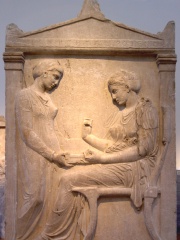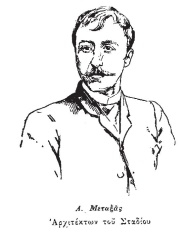





The Most Famous
ARCHITECTS from Greece
This page contains a list of the greatest Greek Architects. The pantheon dataset contains 518 Architects, 7 of which were born in Greece. This makes Greece the birth place of the 21st most number of Architects behind Sweden, and Egypt.
Top 7
The following people are considered by Pantheon to be the most legendary Greek Architects of all time. This list of famous Greek Architects is sorted by HPI (Historical Popularity Index), a metric that aggregates information on a biography's online popularity.

1. Ictinus (b. 500 BC)
With an HPI of 72.84, Ictinus is the most famous Greek Architect. His biography has been translated into 38 different languages on wikipedia.
Ictinus (; Greek: Ἰκτῖνος, Iktinos) was an architect active in the mid 5th century BC. Ancient sources identify Ictinus and Callicrates as co-architects of the Parthenon. He co-wrote a book on the project – which is now lost – in collaboration with Carpion. Pausanias identifies Ictinus as architect of the Temple of Apollo at Bassae. That temple was Doric on the exterior, Ionic on the interior, and incorporated a Corinthian column, the earliest known, at the center rear of the cella. Sources also identify Ictinus as architect of the Telesterion at Eleusis, a gigantic hall used in the Eleusinian Mysteries. Pericles also commissioned Ictinus to design the Telesterion ("Hall of Final Things") at Eleusis, but his involvement was terminated when Pericles fell from power. Three other architects took over instead. It seems likely that Ictinus's reputation was harmed by his links with the fallen ruler, as he is singled out for condemnation by Aristophanes in his play The Birds, dated to around 414 BC. It depicts the royal kite or ictinus – a play on the architect's name – not as a noble bird of prey but as a scavenger stealing sacrifices from the gods and money from men. As no other classical author describes the bird in this fashion, Aristophanes likely intended it to be a dig at the architect. The artist Jean Auguste Dominique Ingres painted a scene showing Ictinus together with the lyric poet Pindar. The painting is known as Pindar and Ictinus and is exhibited at the National Gallery, London.

2. Callicrates (470 BC - 420 BC)
With an HPI of 71.98, Callicrates is the 2nd most famous Greek Architect. His biography has been translated into 41 different languages.
Callicrates or Kallikrates (; Greek: Καλλικράτης [Kaliˈkratis]) was an ancient Greek architect active in the middle of the fifth century BC. He and Ictinus were architects of the Parthenon (Plutarch, Pericles, 13). An inscription identifies him as the architect of "the Temple of Nike" on the Acropolis of Athens (IG I3 35). The temple in question is either the amphiprostyle Temple of Athena Nike now visible on the site or a small-scale predecessor (naiskos) whose remains were found in the later temple's foundations. An inscription identifies Callicrates as one of the architects of the Classical circuit wall of the Acropolis (IG I3 45), and Plutarch further states (loc. cit.) that he was contracted to build the middle of three defensive walls linking Athens and Piraeus. A crater on the planet Mercury was named in his honor.

3. Mnesikles (500 BC - 460 BC)
With an HPI of 68.38, Mnesikles is the 3rd most famous Greek Architect. His biography has been translated into 28 different languages.
Mnesikles (Ancient Greek: Μνησικλῆς; Latin transliteration: Mnesicles) was an ancient Athenian architect active in the mid 5th century BC, the age of Pericles. Plutarch (Pericles, 13) identifies him as architect of the Propylaea, the Periclean gateway to the Athenian Acropolis.

4. Dinocrates (400 BC - 360 BC)
With an HPI of 64.98, Dinocrates is the 4th most famous Greek Architect. His biography has been translated into 23 different languages.
Dinocrates of Rhodes (also Deinocrates, Dimocrates, Cheirocrates and Stasicrates; Ancient Greek: Δεινοκράτης ὁ Ῥόδιος, fl. late 4th century BC) was a Greek architect and technical adviser to Alexander the Great. He is remembered for his plan of Alexandria, the monumental funeral pyre for Hephaestion, and the reconstruction of the Temple of Artemis at Ephesus. Ancient sources and modern historians, including Will Durant in The Story of Civilization, emphasize his role in shaping the architectural vision of Alexander’s empire.

5. Aristobulus of Cassandreia (375 BC - 301 BC)
With an HPI of 63.69, Aristobulus of Cassandreia is the 5th most famous Greek Architect. His biography has been translated into 25 different languages.
Aristobulus of Cassandreia (Ancient Greek: Ἀριστόβουλος ὁ Κασσανδρεὺς; c. 375 BC – 301 BC), Greek historian, son of Aristobulus, probably a Phocian settled in Cassandreia, accompanied Alexander the Great on his campaigns. He served throughout as an architect and military engineer as well as a close friend of Alexander, enjoying royal confidence, and was entrusted with the repair of the tomb of Cyrus the Great in Pasargadae. He wrote an account, mainly geographical and ethnological. It survives only in quotations by others, which may not all be faithful to the original. His work was largely used by Arrian. Plutarch also used him as a reference.

6. Callimachus (500 BC - 460 BC)
With an HPI of 62.79, Callimachus is the 6th most famous Greek Architect. His biography has been translated into 18 different languages.
Callimachus (Ancient Greek: Καλλίμαχος Kallímakhos) was an architect and sculptor working in the second half of the 5th century BC in the manner established by Polyclitus. He was credited with work in both Athens and Corinth and was probably from one of the two cities. According to Vitruvius (iv.1), for his great ingenuity and taste the Athenians dubbed Callimachus katatêxitechnos (literally, 'finding fault with one's own craftsmanship': perfectionist). His reputation in the 2nd century AD was reported in an aside by Pausanias as one "although not of the first rank of artists, was yet of unparalleled cleverness, so that he was the first to drill holes through stones"—that is, in order to enhance surface effects of light and shade in locks of hair, foliage and other details. Thus it is reported that Callimachus was known for his penchant for elaborately detailed sculptures or drapery, though few securely attributed works by him survive.

7. Anastasios Metaxas (1862 - 1937)
With an HPI of 56.90, Anastasios Metaxas is the 7th most famous Greek Architect. His biography has been translated into 20 different languages.
Anastasios Metaxas (Greek: Αναστάσιος Μεταξάς; 27 February 1862 – 28 January 1937) was a Greek architect and shooter.
People
Pantheon has 7 people classified as Greek architects born between 500 BC and 1862. Of these 7, none of them are still alive today. The most famous deceased Greek architects include Ictinus, Callicrates, and Mnesikles.
Deceased Greek Architects
Go to all RankingsIctinus
500 BC - Present
HPI: 72.84
Callicrates
470 BC - 420 BC
HPI: 71.98
Mnesikles
500 BC - 460 BC
HPI: 68.38
Dinocrates
400 BC - 360 BC
HPI: 64.98
Aristobulus of Cassandreia
375 BC - 301 BC
HPI: 63.69
Callimachus
500 BC - 460 BC
HPI: 62.79
Anastasios Metaxas
1862 - 1937
HPI: 56.90

